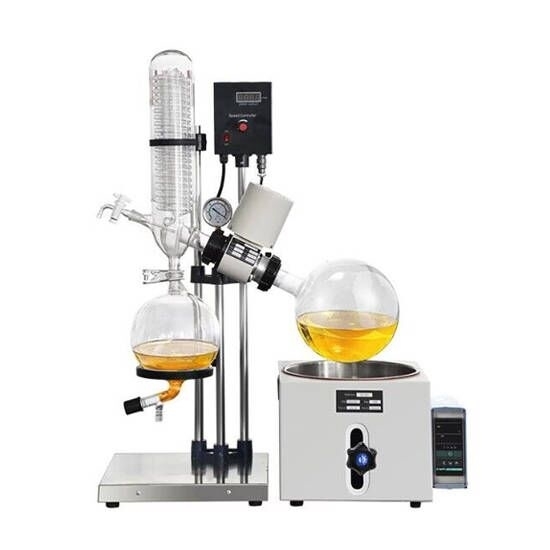
- Stock: In Stock
- Model: RDDLZ-RVE-2L
- Weight: 1.00
- SKU: RDDLZ-RVE-2L
Available Options
Buy a flexible rotary vacuum evaporator online, available with evaporation capacity of 20L/min and adjustable speed of 10-180 rpm.RDDLZ rotary vacuum evaporator is the ideal solution for solvent evaporation, concentration and distillation applications.
Specification
| Model | RDDLZ-RE-250 |
| Speed Adjustment Range | 10-180 rpm |
| Evaporation capacity | 20 ml/min |
| Achievable Cacuum | -0.095 MPa or less |
| Temperature Adjustment Range | Room temperature -99/180°C |
| Temperature Setting Display | Key input, digital display |
| Speed Setting Display | Button setting, digital display |
| Safety Function | Fuse |
| Lift Function | Manual lift |
| Rotary Motor | 40W |
| Heating Power | 1.5kW |
| Condenser | Vertical double serpentine condenser |
| Condensation Area | 0.15m2 |
| Evaporation Speed | >1.2L/min H20 |
| Spinner Bottle | >0.5-2L |
| Collection Bottle | 1L/35# ball mill mouth |
| Vacuum Seal | PTFE+Teflon combined seal |
| Water Bath Size | 240*150mm |
| Lifting Stroke | 100-150mm |
| Applicable Smbient Temperature | 5-35°C |
| Power Supply Voltage | 220V/50Hz |
| Dimension | 630*330*1060m |
| Weight | 22kg |
Features
- PTFE and fluororubber dual sealing ensure high vacuum degree.
- The exhaust nozzle of the condenser is positioned below for safer connection with the vacuum tube.
- The rotary vacuum evaporator has a modular design with strong scalability.
- Convenient lifting operation to avoid movement of the glass parts, ensuring safety and ease of use.
- The rotational speed and bath temperature are displayed digitally and controlled by PID for high temperature control accuracy.
- The bath is separated from the 3L rotary evaporator, allowing flexible configuration.
Applications
Rotary evaporators are commonly used in laboratories and industries for efficient solvent evaporation and concentration processes, such as in pharmaceutical research, chemical synthesis, and essential oil extraction.
Tips: How to set up a rotary evaporator?
Setting up a rotary evaporator involves several steps. Here's a general guide to help you with the setup process:
- Location: Choose a well-ventilated area with a stable bench or table to place your rotary evaporator. Ensure there's enough space around the equipment for easy access and operation.
- Power Supply: Check the power requirements of your rotary evaporator and ensure you have a compatible power outlet nearby. Make sure the power supply is grounded properly.
- Assemble the Glassware: Most rotary evaporators consist of a water bath, heating bath, rotating flask, condenser, and collection flask. Assemble the glassware components according to the manufacturer's instructions. Typically, you'll need to connect the condenser to the heating bath and attach the rotating flask to the rotary evaporator motor.
- Connect the Vacuum Pump: Attach the vacuum pump to the rotary evaporator. Follow the manufacturer's instructions for connecting the vacuum tubing from the vacuum pump to the condenser. Ensure the vacuum pump is in good working condition and properly maintained.
- Fill the Water Bath: Add distilled water to the water bath to the appropriate level as indicated by the manufacturer. Some rotary evaporators may require the addition of an appropriate heat transfer fluid instead of water. Refer to the equipment manual for specific instructions.
- Prepare the Sample: Transfer your liquid sample into the rotating flask. Ensure the flask is properly secured to the rotary evaporator motor.
- Attach the Condenser: Connect the condenser to the heating bath. The condenser should be securely attached, and the tubing should be properly connected between the condenser and the vacuum pump.
- Adjust the Temperature: Set the desired temperature on the heating bath controller. Allow the heating bath to reach the set temperature before proceeding.
- Start the Rotation: Turn on the rotary evaporator motor to begin rotating the flask. Adjust the rotation speed according to your requirements. Higher speeds can increase evaporation rates, but be cautious not to cause excessive splashing or foaming.
- Apply Vacuum: Turn on the vacuum pump to create a vacuum inside the system. Adjust the vacuum level based on the boiling point of your sample. Lower pressures help to reduce the boiling point and facilitate evaporation.
- Monitor the Process: Keep an eye on the evaporation process, ensuring the liquid level in the rotating flask doesn't drop too low. If needed, add more samples or adjust the vacuum and temperature settings accordingly.
- Collect the Distillate: As the sample evaporates, the distillate will condense in the condenser and collect in the collection flask. Ensure the collection flask is empty and properly positioned to collect the distillate.
- Shutdown: Once the desired evaporation is complete, turn off the rotary evaporator motor, vacuum pump, and heating bath. Allow the system to cool down before disassembling the glassware.
Remember, these steps provide a general guideline, and it's essential to refer to the specific instructions and safety guidelines provided by the manufacturer of your rotary evaporator for accurate setup and operation.
